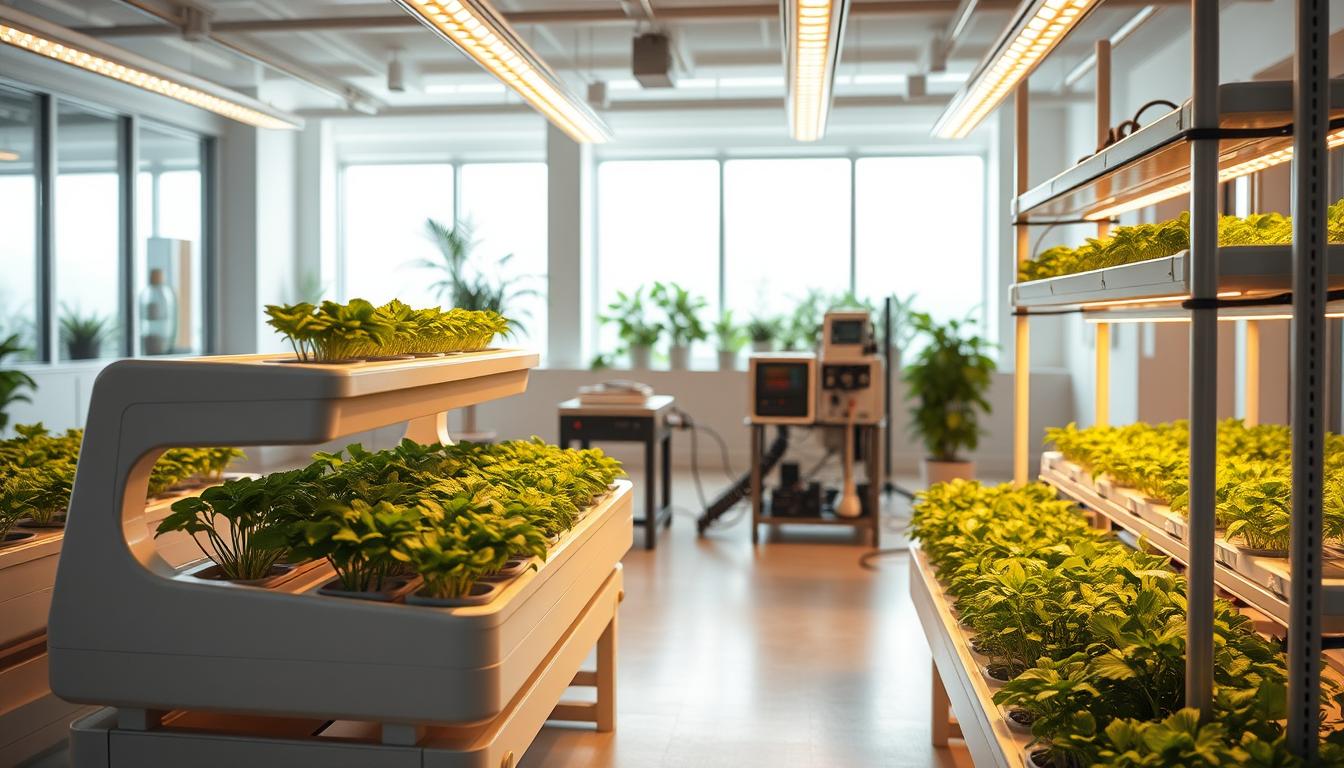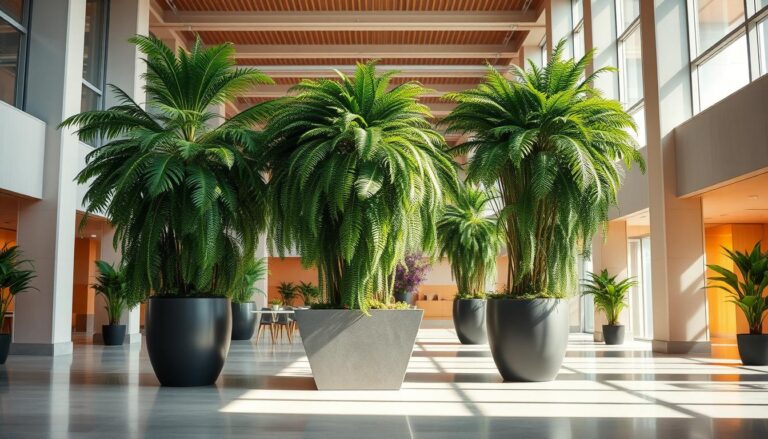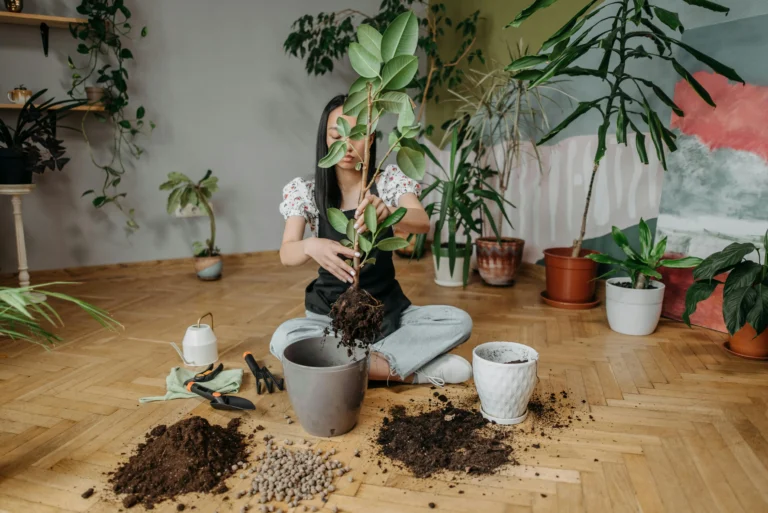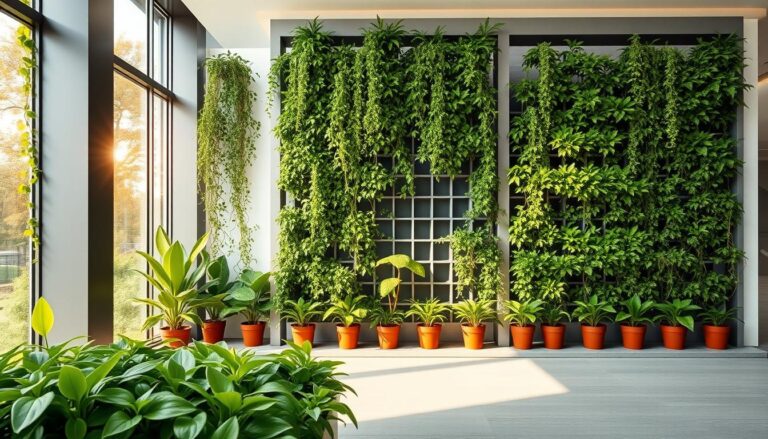The Ultimate Guide to Starting a Hydroponic Garden
When I first found out about hydroponic gardening, it felt like discovering a secret. My small apartment kitchen turned into a green oasis. It showed that you can grow fresh food without soil.
Imagine picking crisp lettuce, juicy tomatoes, and fragrant herbs from your home. A hydroponic garden is more than a gardening method. It’s a way to grow food that saves space, water, and boosts yields.
Hydroponic gardening lets you become an urban farmer. It breaks free from old farming limits. You can grow plants up to 30% faster and use 95% less water. This method is a step towards sustainable food production.
Table of Contents
Understanding Hydroponic Gardening Basics
Hydroponic gardening is a new way to grow plants without soil. It uses a water solution full of nutrients to help plants grow well. This method makes growing plants more efficient and controlled.
A hydroponic garden changes how we grow plants. It gives plants nutrients directly, making them grow faster and stronger than in soil.
What is Hydroponics?
Hydroponics means growing plants in water with nutrients. The roots hang in a solution that gives them everything they need. This way, plants can grow up to 50% faster than in soil.
Benefits of Hydroponic Growing
- Faster plant growth rates
- Up to 30% higher crop yields
- Reduced water consumption (up to 90% less)
- Year-round cultivation potential
- Pest and disease reduction
“Hydroponics is not just gardening; it’s a scientific approach to plant cultivation.” – Agricultural Innovation Expert
Common Misconceptions
Some think hydroponic gardening is hard or that the food tastes bad. But, a good hydroponic garden can grow tasty, healthy food with little work.
Hydroponic gardening works for small herb gardens or big farms. It’s a great choice for anyone who wants to grow plants in a new way.
Essential Components of a Hydroponic Garden

To make a hydroponic garden work well, you need to know its key parts. These parts help create a great place for plants to grow. They make sure your plants grow well and you get a good harvest.
Your hydroponic garden needs five main parts to grow plants without soil:
- Water distribution system
- Oxygenation mechanism
- Nutrient solution
- Growing medium
- Lighting system
Each part is crucial for plant growth. The water system makes sure plants get the nutrients they need. Oxygen helps roots grow strong. Nutrients give plants the food they need, like soil does.
| Component | Function | Key Considerations |
|---|---|---|
| Growing Medium | Supports plant roots | Rockwool, expanded clay pellets, coco coir |
| Nutrient Solution | Provides plant nutrition | Balanced macro and micronutrients |
| Lighting | Supports photosynthesis | Red and blue wavelengths preferred |
When picking parts for your hydroponic garden, think about your plants, the system’s complexity, and what you want to achieve. Choosing high-quality parts can really boost your garden’s output.
Pro tip: Hydroponic systems can yield 2-10 times more produce compared to traditional soil-based gardening!
Knowing these key parts will help you build a successful hydroponic garden. It will help your plants grow well and use less resources.
Choosing the Right Hydroponic System
Choosing the right hydroponic garden system is key for growing plants well. Each system has its own benefits, helping you pick the best one for your needs. Knowing what each system offers will guide your choice.
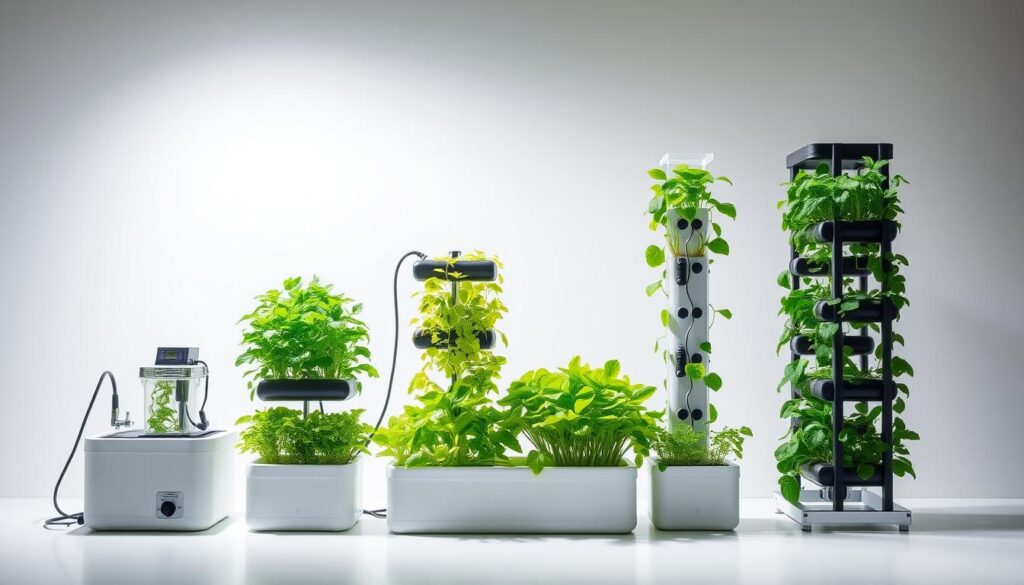
Hydroponic gardening has come a long way since 1699. Now, many systems are available for gardeners. Let’s look at the most common ones:
Deep Water Culture (DWC)
Deep Water Culture is a simple method. Plants hang in water full of nutrients, with constant oxygen. It’s great because:
- It needs little equipment
- It’s perfect for beginners
- It’s best for small, fast-growing plants
Nutrient Film Technique (NFT)
Nutrient Film Technique has a thin nutrient film flowing over roots. It offers:
- Roots get lots of oxygen
- Nutrients are delivered well
- It’s great for leafy greens and herbs
Ebb and Flow Systems
Ebb and Flow systems flood roots with nutrients then drain. This creates good growing conditions. It’s good because:
- It works for many plants
- Nutrients and oxygen are controlled
- It’s good for medium to large plants
Drip Systems
Drip systems slowly give nutrients to roots through tubes. It’s good for:
- Managing nutrients well
- Using water efficiently
- Working with different plant sizes
“Choosing the right hydroponic system is about understanding your plants’ specific needs and your gardening goals.” – Hydroponic Expert
Your hydroponic garden’s success depends on picking the right system. Consider your space, plants, and experience. Try different methods to find what works best for you!
Selecting Plants for Your Setup
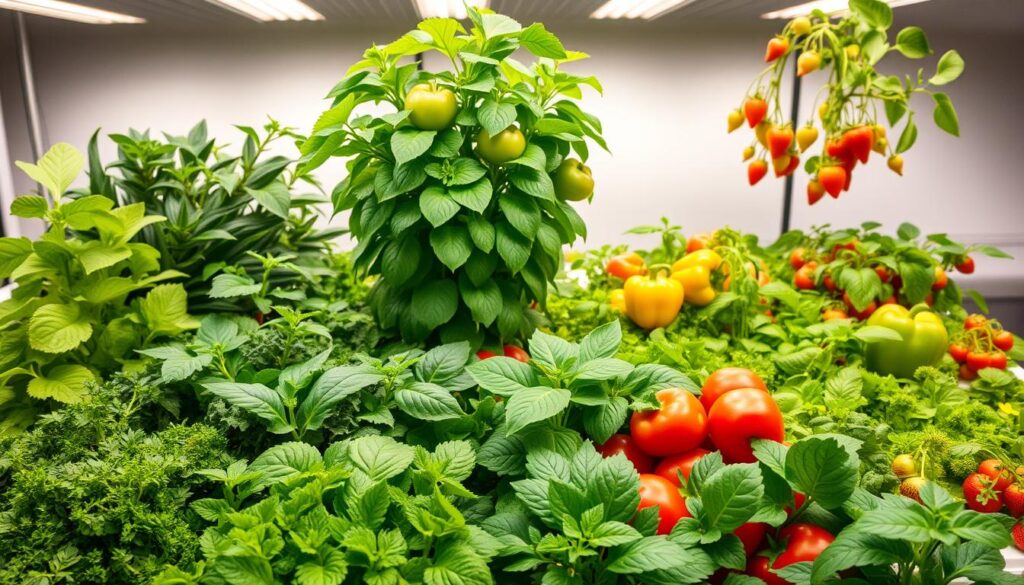
Choosing the right plants is key for a thriving hydroponic garden. Not all plants do well in hydroponic systems. Knowing which ones are best can greatly improve your growing success.
For beginners, some plants are perfect for hydroponic growing. Here are some top picks:
- Leafy Greens: Lettuce, spinach, kale, and Swiss chard
- Herbs: Basil, mint, oregano, and thyme
- Quick-growing Vegetables: Radishes and green onions
When picking plants for your hydroponic garden, keep these points in mind:
- Growth Rate: Pick fast-growing plants that mature quickly
- Root Structure: Shallow-rooted plants are best for smaller systems
- Nutrient Requirements: Match plants with the right nutrient solutions
Bigger hydroponic setups can handle more demanding plants like tomatoes, peppers, and cucumbers. These need extra support and more complex nutrient management. For example, leaf lettuce is ready in 3-4 weeks, while tomatoes take longer but yield a lot.
Pro tip: Start with easy plants to build your confidence. As you get more experience, try more challenging crops and varieties in your hydroponic garden.
Lighting Requirements and Solutions
Lighting is key to a successful hydroponic garden. The right light can boost your plants’ growth, turning a simple setup into a thriving space. Knowing what light your plants need is crucial for a healthy environment.
LED Grow Lights: The Modern Solution
LED grow lights have changed hydroponic gardening. They are efficient and can be tailored to your needs. These lights offer several benefits:
- Energy-efficient performance
- Customizable light spectrum
- Low heat generation
- Long-lasting durability
Mastering Light Cycles and Positioning
Getting light positioning right is essential. Wrong placement can harm your plants. Most plants do well with:
- 18 hours of light during vegetative stages
- 12 hours of light during flowering phases
- Consistent light distance from plant canopy
Natural vs Artificial Light
Natural sunlight is best, but artificial lighting offers control. LED lights mimic sunlight with specific wavelengths:
- Blue light (445 nm): Promotes vegetative growth
- Red light (650 nm): Supports flowering and fruiting
The goal is to create a balanced light environment that mimics nature while giving you control.
Invest in quality timers for consistent light cycles. This will help your hydroponic garden thrive. With the right approach, you’ll have a perfect growing space for your plants.
Nutrient Management and Water Quality
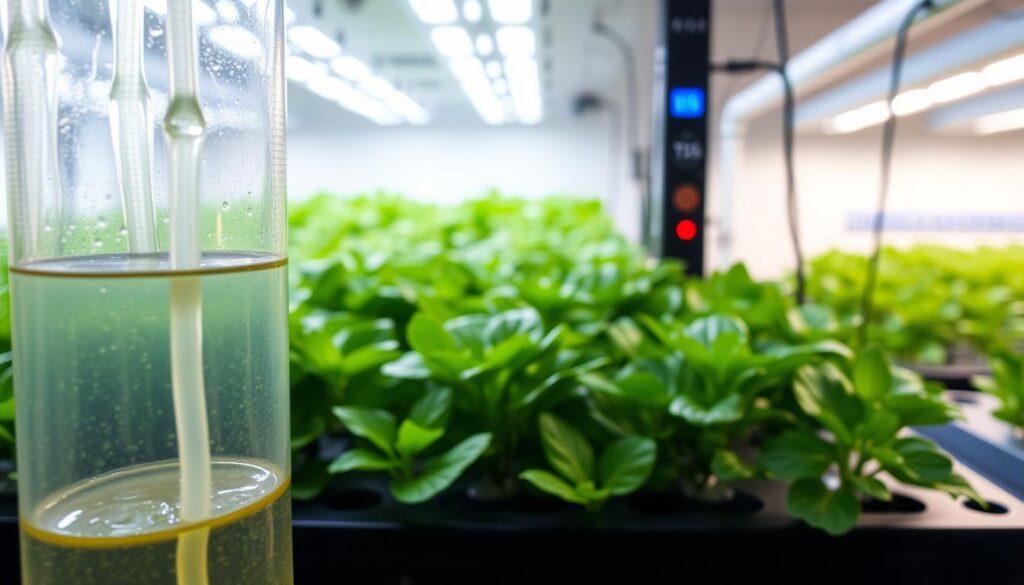
Mastering nutrient management is key for a thriving hydroponic garden. Your plants need the right nutrients and water quality to grow well. Unlike soil gardens, hydroponics require balanced nutrient solutions for growth.
Essential nutrients for your hydroponic garden include:
- Macronutrients: Nitrogen, Phosphorus, Potassium
- Micronutrients: Iron, Magnesium, Calcium
- Secondary nutrients: Sulfur, Magnesium
Water quality is vital for nutrient absorption. Most crops prefer a pH between 5.4 and 7. Keeping the right pH ensures nutrients are available to your plants.
“Clean water is the foundation of a healthy hydroponic garden” – Hydroponic Expert
When making nutrient solutions, remember these important points:
- Use filtered or distilled water to avoid contaminants
- Check water electrical conductivity (EC)
- Watch mineral content often
- Change nutrient levels as plants grow
Chlorine levels should be under 70 ppm to protect plants. Active aeration systems with airstones help keep water oxygen levels high. This supports strong root growth in your hydroponic garden.
Environmental Control for Optimal Growth
Creating the perfect environment is key for a successful hydroponic garden. Your plants’ health depends on precise climate management. This goes beyond traditional gardening techniques. Mastering environmental control can dramatically improve your crop yields and overall plant quality.
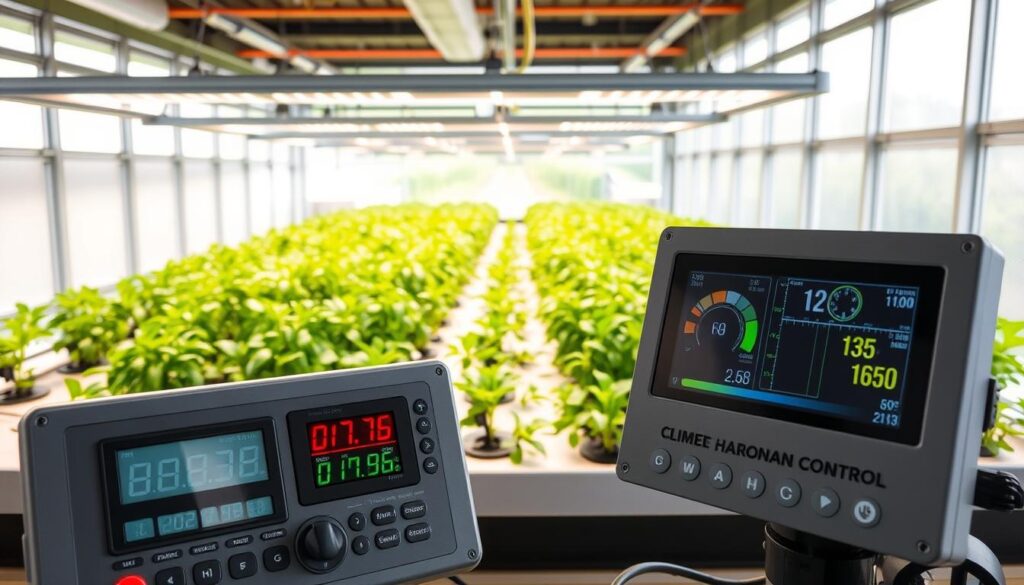
Temperature Management
Temperature is crucial for your hydroponic garden’s success. Most plants thrive between 68-70°F. Some crops may need slight variations. Rapid temperature changes can stress plants, potentially reducing their growth and productivity.
- Monitor temperature consistently
- Use digital thermometers for precision
- Install heating or cooling systems as needed
“Consistent temperature is the foundation of healthy plant growth in hydroponics.” – Agricultural Research Institute
Humidity Control
Maintaining optimal humidity levels is essential for your hydroponic garden. Ideal relative humidity ranges between 40-60%. This supports robust plant development and prevents disease risks.
- Use dehumidifiers to regulate moisture
- Implement proper ventilation
- Monitor humidity with digital hygrometers
Air Circulation
Effective air circulation strengthens plant stems and prevents fungal growth. Strategic fan placement ensures even distribution of temperature and humidity throughout your hydroponic garden.
- Position fans to create gentle, consistent airflow
- Avoid direct blowing on plant leaves
- Rotate fan positions periodically
Pro tip: Invest in quality environmental control equipment to maximize your hydroponic garden’s potential and minimize potential growth challenges.
Setting Up Your First Hydroponic Garden
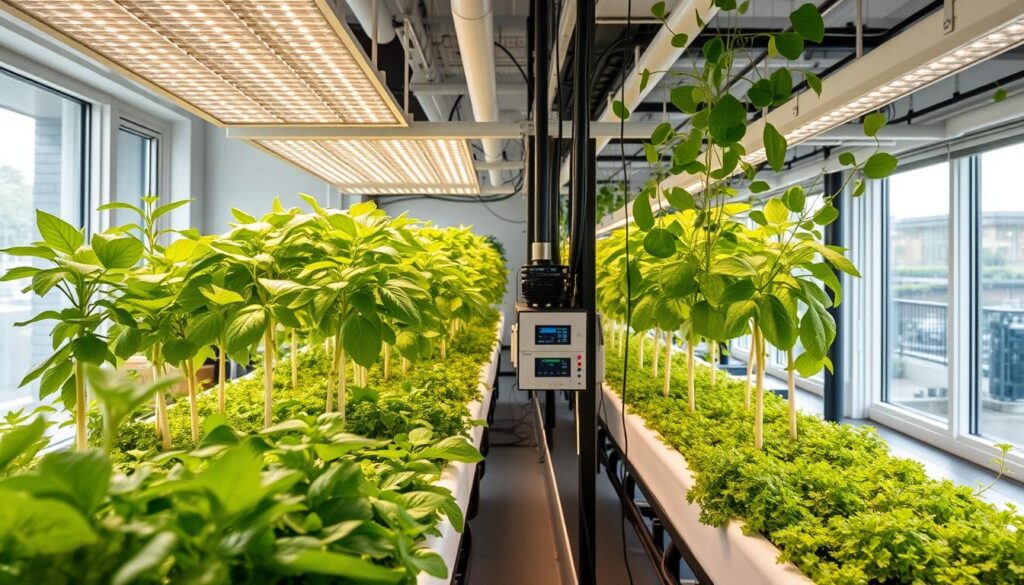
Starting your first hydroponic garden is an exciting journey into modern growing methods. It might seem complex, but with the right steps, you’ll grow fresh produce quickly.
Here are the key steps to set up a successful hydroponic garden:
- Choose Your Location
- Find a spot with a stable temperature
- Make sure it has electrical outlets nearby
- It needs good air flow
- Select Your System
- Beginners should start with an ebb-and-flow system
- Think about the space and the plants you want to grow
When setting up your hydroponic garden, choosing the right plants is key. Start with leafy greens like lettuce. Use rapid rooter cubes to boost germination. General Hydroponics Rapid Rooter has over 11,700 positive reviews.
| Component | Recommended Product | Key Features |
|---|---|---|
| Grow Light | VIPARSPECTRA P2000 LED | Full spectrum, energy-efficient |
| Growing Medium | Mother Earth Hydroton Clay Pebbles | Excellent drainage, reusable |
| Nutrient Solution | Dyna-Gro Grow | Balanced vegetative growth formula |
| pH Tester | APERA INSTRUMENTS pH Tester | Accurate readings, easy to use |
Your hydroponic garden’s success depends on the right conditions. Keep the pH between 5.5 and 6.5. Give plants 12-16 hours of light each day. With good care, plants grow up to 50% faster than in soil.
Pro Tip: Start small, learn from each growth cycle, and gradually expand your hydroponic garden.
Maintenance and Monitoring
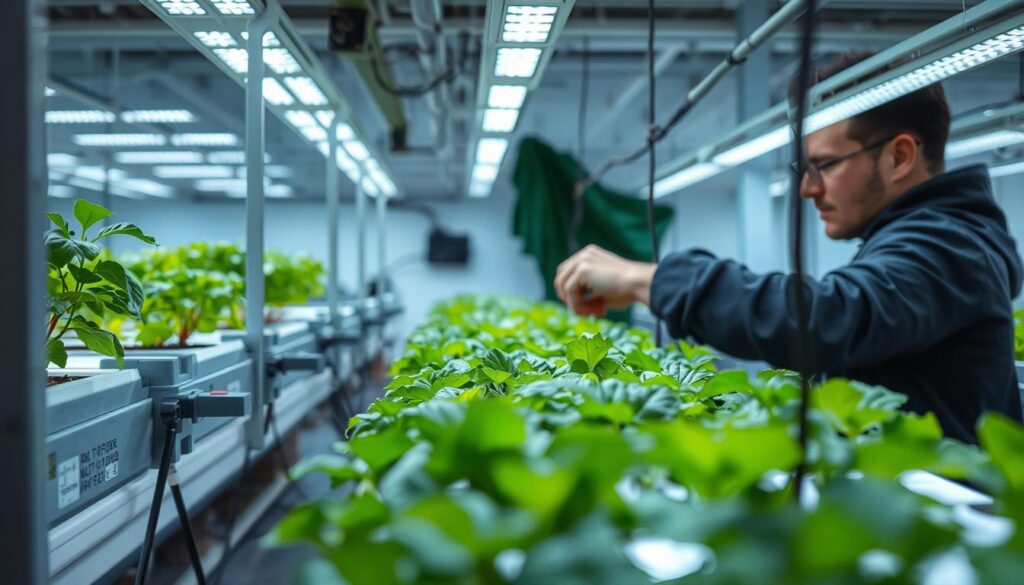
Keeping your hydroponic garden healthy needs regular care. It’s important to maintain it well to ensure your plants grow well. A routine check can help spot problems early and keep your garden in top shape.
Key tasks for your hydroponic garden include:
- Checking nutrient solution levels weekly
- Monitoring pH and electrical conductivity (EC)
- Cleaning reservoir and system components
- Inspecting plants for signs of stress or disease
- Maintaining proper water temperature
Your hydroponic reservoir needs extra care. Experts suggest cleaning it every 2 to 6 weeks. Use a diluted hydrogen peroxide or vinegar solution for cleaning. Make sure to rinse well and let it dry to avoid residue.
Digital tools can make maintenance easier. A digital nutrient meter can track water quality accurately. Filtration systems keep water clean, and air pumps ensure oxygen and humidity.
Consistent monitoring is the foundation of a successful hydroponic garden.
Preventive steps are key to a healthy hydroponic system. Use pest management strategies, keep the area clean, and check grow lights and parts often. Being proactive helps your plants thrive.
Troubleshooting Common Issues
Even the most well-kept hydroponic garden can face problems. Knowing how to spot and fix common issues is key to keeping your plants healthy.
Successful hydroponic gardening means watching closely and solving problems fast. Most problems come from the environment, how you manage nutrients, or keeping the system in good shape.
Nutrient Deficiencies
Nutrient shortages can really hurt your hydroponic garden’s health. Spotting these early is vital for your plants.
- Look for color changes in leaves
- Monitor plant growth rates
- Check N-P-K nutrient ratios regularly
| Nutrient | Deficiency Symptoms | Quick Fix |
|---|---|---|
| Nitrogen | Yellowing lower leaves | Adjust nutrient solution |
| Phosphorus | Dark green or purplish leaves | Increase phosphorus levels |
| Potassium | Brown leaf edges | Balanced nutrient mix |
pH Imbalances
pH levels are key for nutrient uptake in your hydroponic garden. Most plants do best between 5.5 and 6.5 pH.
- Test pH weekly
- Use calibrated pH meters
- Adjust with pH up/down solutions
Root Problems
Root health is super important in hydroponic systems. Look out for signs of stress or disease.
- Prevent root rot by keeping solution temperature below 75°F
- Ensure proper air circulation
- Use beneficial microorganisms
By being alert and fixing problems quickly, you can keep your hydroponic garden thriving. This way, you’ll get healthy, strong plants.
Conclusion
Starting a hydroponic garden is a big step towards growing your own food. It saves up to 90% of water and lets you grow food all year. This method is great for small spaces.
People living in cities and those who love food will love hydroponics. It lets you grow more food in less space. You can grow over 140 types of plants, like greens and herbs.
Hydroponics is getting easier to start thanks to new tech. You can find simple kits and use green energy. It’s a way to grow food that’s good for the planet.
Now is the time to start your hydroponic garden. You’ve learned how to make a space that grows food well. It’s a chance to be part of a movement for better food and less waste.

